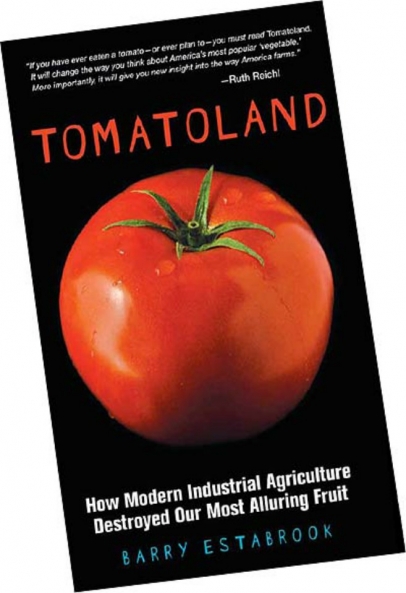Edible Read: Tomatoland
Sometimes ignorance is bliss … but most of the time it is not and that in itself is a good reason to go out and get a copy of Tomatoland. Barry Estabrook, a James Beard Award–winning author, will take you on a journey to parts of Florida one is not likely to see on beach vacations. And it’s a journey one should think about when reaching for that perfectly shaped Florida tomato at the neighborhood supermarket.
The story begins simply, with Barry finding himself behind a heavy truck in Florida, laden with what appear to be green Granny Smith apples. Some of these orbs begin to fly off the truck, but they turn out to be tomatoes “so plasticine and so identical they could have been stamped out by a machine.” A few have cracks, most are unblemished and not one is smashed, despite a drop at 60 mph.
Intrigued by that event, Barry begins his investigation. He soon discovers that, of all the fruits and vegetables we eat, none suffers at the hand of factory farming more than a tomato grown in the winter fields of Florida, which accounts for one-third of the fresh tomatoes grown in the United States. Modern agribusiness can’t deliver a decent-tasting tomato in large part because it’s essentially against the law: Regulations set by the Florida Tomato Committee determine what a tomato should look like, and the older, tasty varieties don’t conform to these rules of color and shape.
The reader also discovers:
- Florida’s humid weather is possibly the worst place for tomato growing. This is overcome by heavy use of chemical fertilizers, pesticides and herbicides.
- The underpaid workers in Florida’s tomato fields are exposed to chemicals daily, with a toll including cancers, respiratory ailments and severe birth defects. That’s not all — one assistant U.S. attorney referred to Florida’s tomato fields as “ground zero for modern-day slavery,” complete with beatings and being “sold” to crew bosses to pay debts.
- A tomato today contains less vitamin C, thiamin, niacin and calcium and 14 times as much sodium as its 1960s counterpart. As Barry explains, consumers and society pay a price when we remove taste and thought from our food purchase decisions. In less than 200 easy-to-read pages, this book will have an impact — and with more knowledge better choices will be made.
About Barry Estabrook
Investigative journalist Barry Estabrook’s 2009 article for Gourmet magazine, “Politics of the Plate: The Price of a Tomato,” won a James Beard Award in 2010. In addition to being a Gourmet contributing editor, Barry was founding editor of EatingWell magazine and has written for the New York Times Magazine, Reader’s Digest, Men’s Health and the Washington Post.
EXCERPT
“ … a gardener can select pretty much any sunny patch of ground, dig a small hole, put in a tomato seedling, and come back two months later and harvest something. Not necessarily a bumper crop of plump, unblemished fruits, but something.
When I met Monica Ozores-Hampton, a vegetable specialist with the University of Florida, I asked her what would happen if I applied the same laissez-faire horticultural practices to a tomato plant in Florida. She shot me a sorrowful, slightly condescending look and replied, “Nothing.” “ Nothing?” I asked. “There would be nothing left of the seedling,” she said. “Not a trace. The soil here doesn’t have any nitrogen, so it wouldn’t have grown at all. The ground holds no moisture, so unless you watered regularly, the plant would certainly die.
And, if it somehow survived, insect pests, bacteria, and fungal diseases would destroy it.” How can it be, then, that Florida is the source for one-third of fresh tomatoes Americans eat?
Our friends at Carmichael’s Bookstore suggest this book as an excellent read. As a founding member of the Louisville Independent Business Alliance, Carmichael’s represents the kind of retailer where the benefits of buying local can be experienced.






